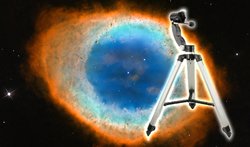


With the exception of the 10mm, the Apertura SWAs all have enough eye relief to be pretty comfortable to use, and the twist-up eyecups can be set to whatever height you find comfortable. There is some field curvature in all of these eyepieces owing to the Erfle design but you may or may not notice it unless you are using a refractor. The blackened lens edges, baffles, and multi-coatings do a good job minimizing glare and internal reflections. There is some lateral chromatic aberration but you are unlikely to notice it except with the 10mm and maybe 15mm when viewing the Moon and planets. The other performance aspects of the Apertura SWAs are very good. If you have a fast scope, the Apertura SWAs’ astigmatism can usually be at least somewhat tolerated. If you have a refractor, SCT, Maksutov, or unusually slow Newtonian, you will get pretty much pinpoint sharp views with any of the Apertura SWA focal lengths available. The 38mm SWA also produces too big of an exit pupil to be used in a scope faster than f/6 given its focal length. However, it should be noted that coma is going to be worse than the SWAs’ edge-of-field astigmatism at f/5 or below anyway, which means that without a coma corrector a nicer eyepiece isn’t going to be of much benefit. In short, these eyepieces are inevitably compromised in any fast Dobsonian. Based on a poll of 10 observers, we can conclude the SWAs perform best with regards to edge-of-field astigmatism as follows: Eyepiece FL The Apertura SWAs show noticeable astigmatism to some degree in telescopes faster than about f/8 and it becomes seriously detrimental to the view at f/6, while the shorter focal lengths don’t start to have issues at all unless you use a telescope with a focal ratio of f/6 or faster and they still work acceptably at f/4.5 or so. Thus, the longer the focal length of the eyepiece, the worse the astigmatism gets. the wider the field lens or faster f/ratio) the worse this is. It is caused by the way the Erfle design bends light entering at an angle. The main issue as you approach the edges of the field of view is astigmatism, which manifests as cross or line-shaped stars and is often confused with coma. The Apertura SWAs stretch the eyepiece design’s apparent field to 70 degrees, which of course means the outer edges are not as well-corrected.

The Erfle design works best at focal ratios of f/8 or above. The Erfle is optimized for a 60-degree apparent field but some manufacturers have stretched it as far as 85 degrees however it generally performs extremely poorly towards the edges of the field if it is not limited to 70 degrees or less. The Erfle design was intended to improve the apparent field of view of binoculars and spotting scopes during World War I and many binoculars made during or after World War II use Erfle eyepieces to achieve a wide apparent field of view. It uses a cemented doublet field lens with a concave surface on the outside and a convex interior surface, a middle lens which is convex on both sides and an eye lens with a convex side towards the interior and a flat surface facing the observer’s eye. The Erfle design dates back to the 1910s, being patented in 1921, and can be seen as sort of an incremental improvement on the Plossl and Kellner. Most other “wide angle” and “SWA” type eyepieces are Erfles or some variation on it. This is the same design that the GSO SuperView eyepieces and the “ goldline” or “redline” eyepieces use – though the 9mm and 6mm goldline/redline use an internal Barlow lens to increase eye relief and improve edge-of-field correction. The Apertura SWAs are, more or less, Erfle eyepieces.


 0 kommentar(er)
0 kommentar(er)
